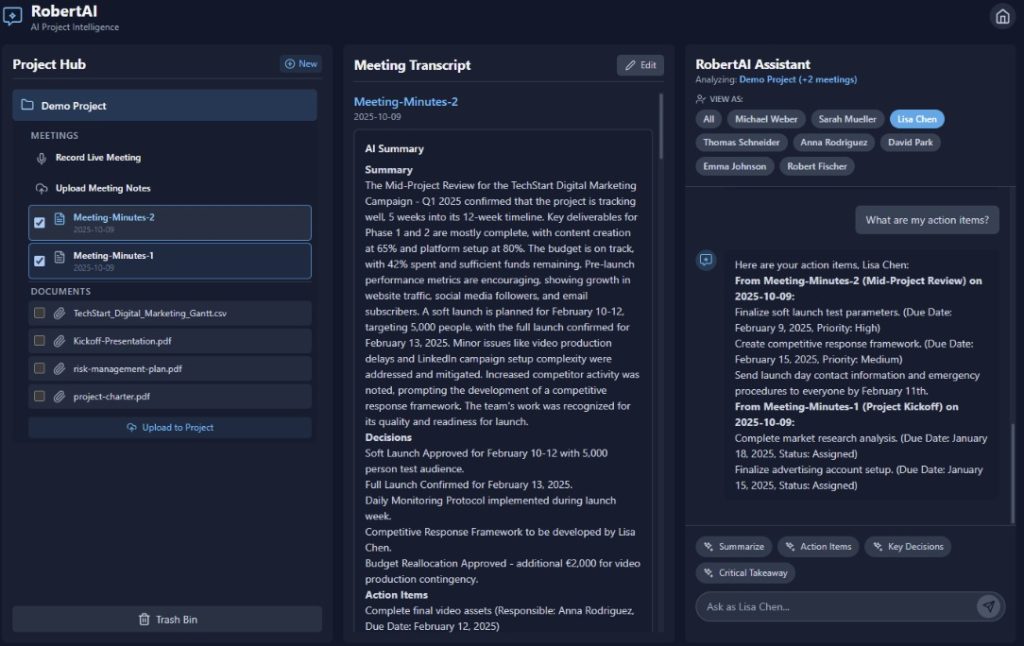Have you ever felt overwhelmed by documents, chats and meetings? In the knowledge economy, keeping on top of the vast amount of information discussed in meetings and stored in a number of tools can be overwhelming, finding the crucial information needed for the current situation can be tedious and time-consuming.
This information overload and the resulting difficulty in retrieval causes project teams in companies to experience a lack of project knowledge and information sharing, leading to inefficiencies in team decision-making and learning (Lacy & Le Roux, 2020).
Meetings are the lifeblood of collaboration, but they generate a huge amount of unstructured data which often disappears the moment they end. Traditional note-taking is a compromise: either you half-listen while typing, or you fully engage with no record to show for it. RobertAI was built to solve this problem.
RobertAI is an AI-powered meeting intelligence platform that serves as the central hub for your projects. It captures, analyses and organises all project related data into permanent, searchable and actionable knowledge.

RobertAI’s strength lies in its ability to intelligently comprehend a wide range of content. Users can record real-time conversations, which the program will then comprehend and transcribe automatically, extracting important conclusions and useful information. Furthermore, users can submit pre-existing transcripts and sophisticated documents such as Word and PDF files. The text is then intelligently extracted by the AI, converting structured and unstructured data into an asset that can be analysed. This intelligence is founded on a strong knowledge base for every project. Teams can upload and manage any relevant information, including design mock-ups, spreadsheets and initial briefs, using this centralised knowledge hub.
Another noteworthy feature is the ability to take notes directly within the programme, which provides a simple way to record spontaneous ideas. Thanks to the combination of structured files and unstructured notes, all project-related data is kept in one easily accessible location, eliminating information asymmetry and ensuring that everyone involved is kept informed about ongoing matters.
Finally, the Chat-Feature is particularly useful when questions arise or things in the documentation remain unclear. Users can discuss their projects in natural language via the chat interface and find whatever they need by simply asking questions. For example, users can ask specific queries such as ‘Summarise the client’s comments from last week’s call based on the transcript and the attached PDF brief’. Users can even narrow in the scope of their enquiries by selecting specific meetings and publications from the Knowledge Hub to specify where RobertAI should gather the answers from.
Designed to be the hyper-intelligent participant in every meeting, RobertAI ensures that your team’s collective intelligence isn’t overlooked. It eliminates the administrative burden of post-meeting tasks, allowing everybody to focus on delivering value and doing their work rather than being stuck in administrative tasks. Say goodbye to meeting amnesia and hello to a smarter, more informed workflow. It’s time for RobertAI.
Team 42: Juul van Gurp (546066jg), Evie Burghouts (581928eb), Palle de Veer (761154pv), Johannes Erath (785513je)
Reference
Lacy, A., & Le Roux, S. (2020). A review of group memory enhancing learning and knowledge practices in team meetings. ResearchGate. https://www.researchgate.net/publication/344149069_A_review_of_group_memory_enhancing_learning_and_knowledge_practices_in_team_meetings/citation/download
